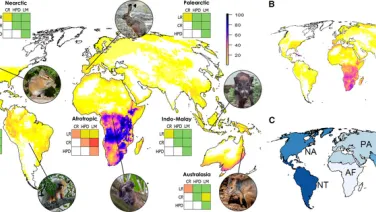
Cardillo Group - Macroevolution, Macroecology and Biogeography
We are interested in big-picture questions about biodiversity. Why are there so many species in the tropics? How have some places become biodiversity hotspots?
Research themes
About
We are interested in big-picture questions about biodiversity. Why are there so many species in the tropics? How have places like southwest Australia become biodiversity hotspots? Why are some species more threatened with extinction than others? To tackle questions like these we use big datasets for plants and animals, and a range of computational tools for analyzing geographic and phylogenetic data. Often, the most fun part is not getting an answer, but getting the question right: thinking about the basic scientific logic of a question about biodiversity, and devising an elegant and creative way of reaching an answer.
We always like welcoming new students, postdocs and visitors, so please get in touch if you are interested in macroevolution, macroecology, biogeography or conservation, and would like to join the lab. My lab is part of the Macroevolution & Macroecology group - you can find out more about what we work on and what we have published at www.macroevoeco.com.
Awards
- ARC Discovery Early Career Researcher Award (DECRA), 2025
- RSB Director's Prize in Honours, 2022
- University Medal for Biology, 2022
- SSB Graduate Student Research Award, 2018
- Transdisciplinary & Innovation Grant, 2016
- Fellow of the Higher Education Academy, 2016
- Birds SA grant, 2015
- J G Russell Award, 2008
- Queen Elizabeth II Fellowship, 2008
- Natural Environment Research Council Fellowship (UK), 2005
Publications
Selected recent publications
Bromham, L. & Cardillo, M. (2019) Origins of Biodiversity: An Introduction to Macroevolution and Macroecology. Oxford University Press
Hua, X., Greenhill, S., Cardillo, M., Schneeman, H. & Bromham, L. (2019) The ecological drivers of variation in global language diversity. Nature Communications 10:2047
Skeels, A. & Cardillo, M. (2019) Reconstructing the geography of speciation from contemporary biodiversity data. The American Naturalist 193: 240-255
Cardillo, M., Weston, P.H., Reynolds, Z.M., Olde, P.M., Mast, A.R., Lemmon, E., Lemmon, A.R., Bromham, L. (2017) The phylogeny and biogeography of Hakea (Proteaceae) reveals the role of biome shifts in a continental plant radiation. Evolution 71: 1928-1943
Skeels, A. & Cardillo, M. (2017) Environmental niche conservatism explains the accumulation of species richness in Mediterranean-hotspot plant genera. Evolution 71: 582-594
Cardillo, M. & Skeels, A. (2016) Spatial, phylogenetic, environmental and biological components of variation in extinction risk: a case study using Banksia. PLoS One
Duchene, D. & Cardillo, M. (2015) Phylogenetic patterns in bird geographic distributions support the tropical conservatism hypothesis. Global Ecology & Biogeography 24: 1261-1268
Warren, D.L., Cardillo, M., Rosauer, D.F., Bolnick, D.I. (2014) Mistaking geography for biology: inferring processes from species distributions. Trends in Ecology & Evolution 29: 572-580
All publications
http://www.macroevoeco.com/marcel-cardillo-publications.html
https://scholar.google.com/citations?hl=en&user=6mBgzU8AAAAJ







